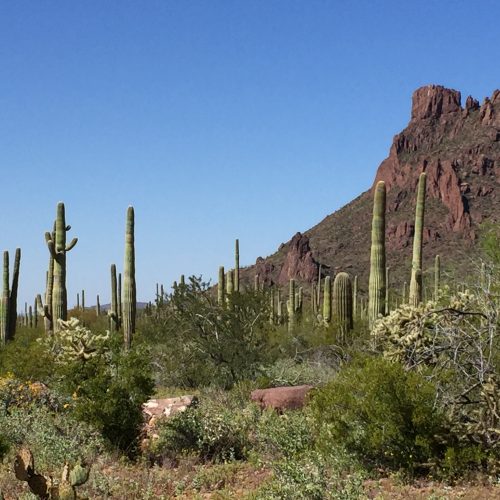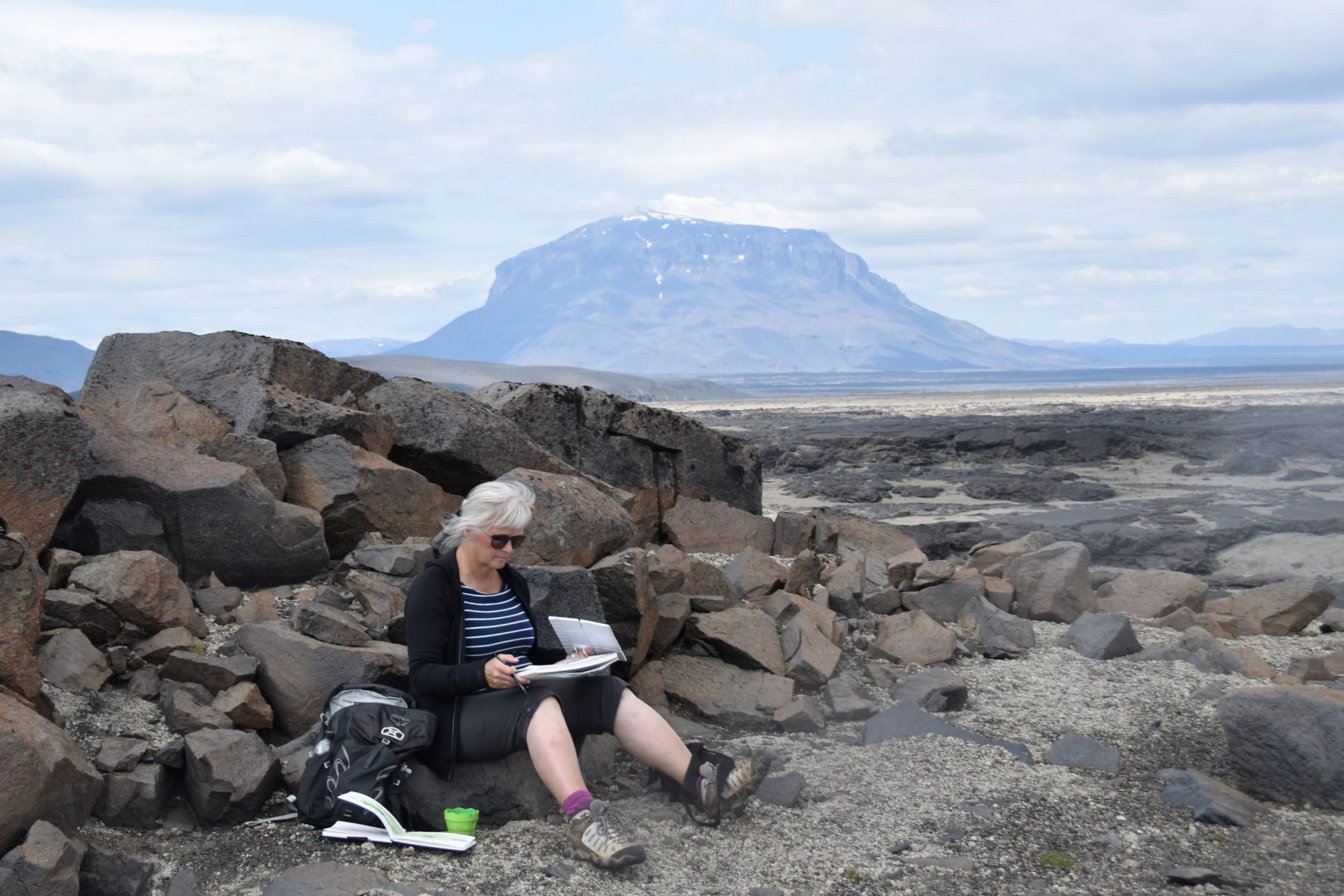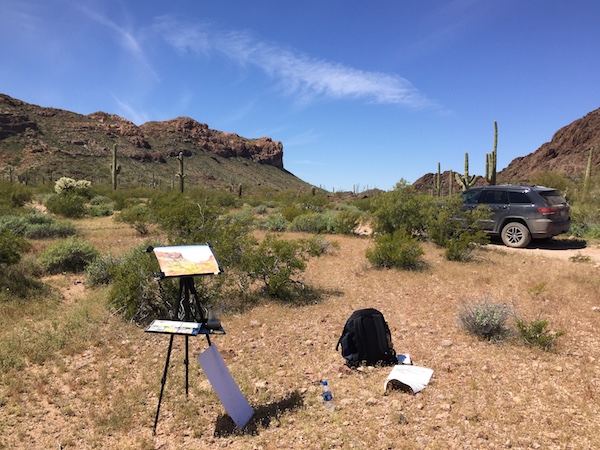
In conversation with: Hayley & Ása
Tutor Hayley Lock chats to student Ása L Aradottir about her interests in ecology and how her passions for her immediate landscape are becoming integrated in your OCA studies. They also discuss how Asa moves her painting practice through the different landscapes of Iceland and Arizona.
HL: Hello Ása,
Thank you so much for agreeing to have this conversation and for sharing aspects of your professional life background as a Professor of Restoration Ecology and its impact on your studies within Painting 1: The Practice of Painting. I am sure that many students will be excited at the prospect of reading around how you navigate a busy and varied career in science alongside the beginnings of a BA (Hons) Degree in Painting.
What I have found fascinating as a tutor is to see how you have fluidly traversed and articulated your ideas and experimental painting processes through an ever changing landscape. Your studio has become portable and you have at times worked with limited resources, as you move from your Icelandic homeland to the deserts of Arizona, where you spent last winter on a sabbatical leave. Both potentially rich environments to work with, I would like to briefly interrogate your approach as well as working processes and ask you to share your thoughts with others in this post.
HL: Your background is in ecology and so as a research scientist. What qualities do you think you bring to painting and what is your particular focus within Painting 1: The Practice of Painting?
AA: My research and teaching deal mostly with ways to improve the condition or health of degraded ecosystems. Ecological restoration essentially seeks to “help nature heal itself” by identifying what hinders natural ecosystem recovery and carefully applying interventions (treatments) to overcome these barriers. Restoration ecologists are therefore constantly trying to understand how ecosystems develop and function. The work I’ve been involved in extends from seedling establishment on a small scale to landscape scale processes of woodland and heathland establishment and how this ultimately affects carbon budgets, which again relates to global climate change. We spend a lot of time in nature doing fieldwork, using a variety of different methods for our research. But keen observation—of the small and of the large—is also extremely important. Perhaps the most valuable skill I bring from my work in science to painting is the close observation, along with knowledge of ecosystems and landscapes and the processes that shape them. But I’m also aware that this might get in the way, as the power of art often lies as much in the untold as what is told.
My main focus with the course Painting 1: The Practice of Painting is to increase my competence as a painter, technically and conceptually, and to expand my means of expression through painting. At this stage I’m therefore more concerned with the process than the outcome.

HL: Iceland and Arizona, as an outsider, share similarities as well as differences and yet you manage to continue your studies through navigating these changes in landscape. Could you briefly explain how you ended up in Arizona and if it has been easy to navigate studio activities from one environment to another? Perhaps you could offer forward a photo of your studio space in Iceland and of your studio space in Arizona?
AA: Last winter I was on a sabbatical leave at the University of Arizona for six months. There, both I and my soil scientist husband were hosted by the School of Natural Resources and the Environment (SNRE), a dynamic institute where we already knew some colleagues. The stay at SNRE exceeded our expectations, not only for the outstanding science but also for their focus on environmental stewardship that seeks to engage the broader community. I was also inspired by the partnerships between scientists and artists I came across in various seminars and exhibitions. Often these partnerships focused on communication about current environmental issues, their gravity and potential solutions, but also on the wonders and intricacies of the natural world.
University of Arizona is in the city of Tucson, which is in southern Arizona not far from the Mexican border. It is set in a beautiful environment of mountain ranges (sky islands) and magnificent desert ecosystems. A national park, named after the Saguaro cactus, borders the city and quite a few national monuments, state parks and wildlife refuge areas are within reasonable driving distance. These surroundings offer ample opportunities for hiking and other outdoor recreation, at least during the winter months when it is not too hot. We tried to take advantage of this when our work allowed, and I would usually take a sketchbook or painting gear along on our trips. But I struggled with painting these landscapes with their complex landforms and flora and a colour palette quite different from the sub-arctic volcanic landscapes of Iceland.
In Tucson, we rented a small, old house with a big garden. As evenings were the main time I had for painting, I ended up working mostly in the tiny kitchen which had the best light. Fortunately, it was not too expensive to go out for dinner! On weekends, I would sometimes paint outside in the backyard. Although the space inside was limited, the dry weather made it possible to leave wet paintings outside to dry and sometimes our back porch was crowded with colour samples, paintings and backgrounds at different stages in the drying process. Getting a sturdy but easily portable plein-air easel proved indispensable for adjusting to various working conditions, and I have actually been using this as my main easel since returning home.
Back in Iceland, my studio space was not much roomier, as it partly serves as a spare bedroom. Now, however, I am in the process of transferring to a larger space as my son just moved out, leaving a large room that I am taking over before he changes his mind. Unfortunately, I do not have any photos of my former studio spaces and the new one is currently under construction.

HH: As your tutor, your connection with the landscape feels very much integrated in your approach to painting your surroundings. Do you think this may have more of an impact as you move forward with your studies?
AA: Probably. But this is a journey and we don’t know where it will take us, do we? There are stories I’d like to tell, but I don’t feel ready for them yet. Hopefully I’ll I figure this out during my studies at OCA. At least for now, much of my inspiration comes from nature, not only from landscapes but also the smaller details of the natural world around us. I find that I increasingly use sketching and painting to observe nature; not merely as a tool to record what I see but also as means to slow down and examine carefully.
HL: Beyond the better known artists that have worked within landscape such as Richard Long, Andy Goldsworthy, Christo and Jeanne- Claude, we have in the UK, The Centre for Contemporary Art and the Natural World (CCANW) and The Wellcome Trust (just two examples) who interrogate and fund ongoing collaborative projects in the field of science, ecology, health and environment. Who has had an immediate impact on your own artistic practice and who do you see leading the field in terms of ongoing artistic/scientific research?
AA: These are tough questions. My own endeavours into art have been influenced, consciously or unconsciously, by numerous artists and artworks. This includes the splendid landscapes of Tacita Dean and the delicate plant paintings by Charlotte Verity. Of contemporary landscape artists that have had immediate impact on my work I have to mention the late Icelandic artist, Georg Guðni. I find that his paintings truly show the essence of the Icelandic highlands as I have experienced them. Going back in time, some of Turner’s more mysterious paintings have captivated me. And Dürer’s The Great Turf was an inspiration, showing the diversity of plants and soil on a very small piece of land, several centuries before anyone thought of the term biodiversity. Having worked with plants and peering into the sward for most of my career, I know that this is where some of the most important processes in nature take place, but most people never notice it. The sward is also complex and messy and very hard to depict in a comprehensive way, which might explain why relatively few artists try to tackle it.
I don’t have enough overview of who is doing what in terms of artistic/scientific collaboration to be able to predict who might be leading that field. Exploring this subject further is on my agenda. I find many of Ólafur Elíasson’s works quite powerful, including his different photo series of disappearing glaciers and changing landscapes. Rúrí’s archive of waterfalls, combining photos and sounds of numerous waterfalls—some that do not exist anymore—is also a strong statement of our impact on nature and touches on a political and ethical issue of how much of these landscapes we should be allowed to destroy in order to fulfill our needs for electricity.
I may be biased, but I find environmental or eco-art most influential and authentic when it is based on good science and/or good understanding of the natural systems that are being examined. The 6 & 6 project—including six pairs of artists and scientists working with the aim to explore the patterns and processes of the Sonoran Desert—is a good example of how interdisciplinary collaboration can generate new and informed ways to look and see. The outcome of such teamwork and cross-pollination is likely to be different from what either party could come up with on its own.
At OCA I am getting an opportunity to study painting, which is something that I have been intrigued by since childhood. For a very long time I did not think of art as “my thing” because I wanted to be an ecologist and have thoroughly enjoyed working in that field for more than three decades. Although it might have been strategic to start the art studies earlier, I find this an exciting time to be at the intersection of art and science.
HL: Thank you Ása, this has been particularly insightful.
Featured image credit: Ása L Aradottir
|
|







Hi Åsa, I enjoyed reading your interview so much. I can totally understand your idea of using keen observation via painting as a natural development of the scientific work. I too come from biology and for me the looking, wonder and enquiry through more ‘artsy eyes’ does allow me a new way to understand ‘things’. Nonverbal, personal and on a sort of ‘other level’ altogether – than my previous ‘counting’ the genes or plant species. I stumbled across this book at the library (Swailes, J. (2016) Field Sketching and the experience of landscape. Oxon, UK and New York, US: Routledge.) and enjoyed it, although my focus is not so much the broad landscape and landscape architecture. I was reminded of this book as I read the interview. / Inger
Thank you Inger,
I fully agree with you that a new way of looking fosters new understanding.
Swailes’ book seems quite relevant. A landscape architecture colleague pointed it out to me some time back—she was planning to use it for a field course. I recently got a copy and am very much looking forward to ‘diving into it’ at the end of this semester when done with teaching.
Hello Asa.
I have just come across this lovely discussion via the Arts & Environment Padlet.
I would love to see your work and follow your process via your blog or social media. Do you have either of these and would you mind sharing?
Many thanks
Alice